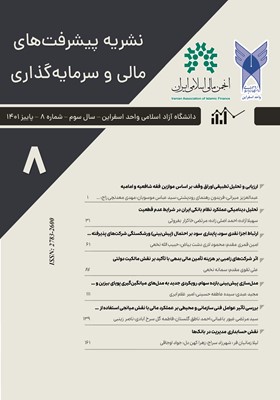مدلسازی پیشبینی بازده سهام، رویکردی جدید به مدلهای میانگینگیری پویای بیزین و پارامتر متغیر زمان
محورهای موضوعی : سرمایهگذاری
مجید عبدی
1
,
سیده عاطفه حسینی
2
*
![]() ,
امیر غلام ابری
3
,
امیر غلام ابری
3
![]()
1 - گروه حسابداری، واحد فیروزکوه، دانشگاه آزاد اسلامی، فیروزکوه، ایران.
2 - گروه حسابداری، واحد فیروزکوه، دانشگاه آزاد اسلامی، فیروزکوه، ایران.
3 - گروه حسابداری، واحد فیروزکوه، دانشگاه آزاد اسلامی، فیروزکوه، ایران.
کلید واژه: ریسک سیستماتیک, بازدهی سهام, ریسک غیرسیستماتیک, عوامل کلان, عوامل خرد,
چکیده مقاله :
هدف: تحقیق حاضر بهدنبال ارائه مدل پیشبینی بازده سهام با استفاده از دادههای خرد، سطح بازار و اقتصاد کلان است.روششناسی پژوهش: تحقیق حاضر از لحاظ روش تحقیق کاربردی است. برآورد مدل میانگینگیری بیزی و TVP_FAVAR در فضای نرمافزار متلب 2021، صورت گرفت. بازه زمانی تحقیق شامل دوره زمانی ۱۳۹۰ تا ۱۳۹۹ است.یافتهها: باتوجهبه خروجی، متغیرها در سطح خرد، سطح بازار و اقتصاد کلان بر این شاخص اثرگذارند؛ همچنین بر اساس نتایج مدل TVPFAVAR مشاهده گردید که اثرگذاری متغیرهای مؤثر بر بازدهی سهام عموماً مثبت و قوی است و این تأثیر عموماً در بلندمدت قویتر از کوتاهمدت است.اصالت / ارزش افزوده علمی: ۶۴ متغیر مؤثر بر بازدهی سهام در سه گروه در سطح خرد، بازار و اقتصاد کلان وارد مدل گردید و سپس با استفاده از رویکرد مدل میانگینگیری بیزی ۱۱ متغیر غیرشکننده مؤثر بر بازدهی سهام که عبارتاند از نسبت جاری، نسبت بدهی، نرخ بازده حقوق صاحبان سهام؛ نسبت قیمت به سود، درآمد نفت، نوسان رشد تولید ناخالص داخلی، نرخ ارز بازار غیررسمی، نوسان تورم، ضریب فزاینده پول، نرخ بهره و ریسک سیستماتیک شناسایی شدند. بدینمنظور برای رفع مشکل مدلهای سنتی که امکان توانایی شناسایی مهمترین متغیرهای مؤثر بر بازدهی سهام را ندارد از روش میانگینگیری بیزی و روش خود رگرسیون برداری تعمیمیافته پارامتر متغیر زمان استفاده شده است.
Purpose: The current research seeks to provide a stock return prediction model using micro, market level and macroeconomic data.Methodology: The current research is applied in terms of research methodology. Bayesian averaging model and TVP_FAVAR were estimated in MATLAB 2021 software environment. The time frame of the research includes the period of 2011 to 2021.Findings: According to the output, variables at the micro level, market level and macro economy affect this index; Also, based on the results of the TVPFAVAR model, it was observed that the effect of the effective variables on stock returns is generally positive and strong, and this effect is generally stronger in the long term than in the short term.Originality / Value: 64 variables affecting stock returns in three groups at the micro, market and macroeconomic levels were entered into the model, and then using the Bayesian averaging model approach, 11 non-fragile variables affecting stock returns, which are current ratio, ratio debt, rate of return on equity; Price-profit ratio, oil income, GDP growth fluctuation, informal market exchange rate, inflation fluctuation, money multiplier, interest rate and systematic risk were identified. For this purpose, to solve the problem of traditional models that do not have the ability to identify the most important variables affecting stock returns, the Bayesian averaging method and the generalized vector autoregression method of the time variable parameter have been used.
Barillas, F., & Shanken, J. (2017). Which Alpha? The Review of Financial Studies, 30(4), 1316–1338.
Carhart, M. M. (1997). On Persistence in Mutual Fund Performance. The Journal of Finance, 52(1), 57.
Fama, E. F., & French, K. R. (2008). Dissecting Anomalies. The Journal of Finance, 63(4), 1653–1678.
Hou, K., Mo, H., Xue, C., & Zhang, L. (2018). Which factors?. Review of Finance, 23(1), 1–35.
Koop, G., & Korobilis, D. (2013). A New Index of Financial Conditions. SSRN Electronic Journal.
Zhang, L. (2017). The Investment CAPM. European Financial Management, 23(4), 545–603.
_||_

